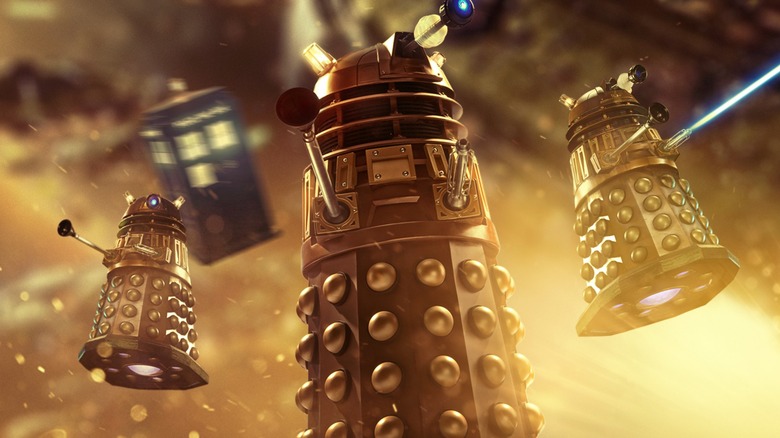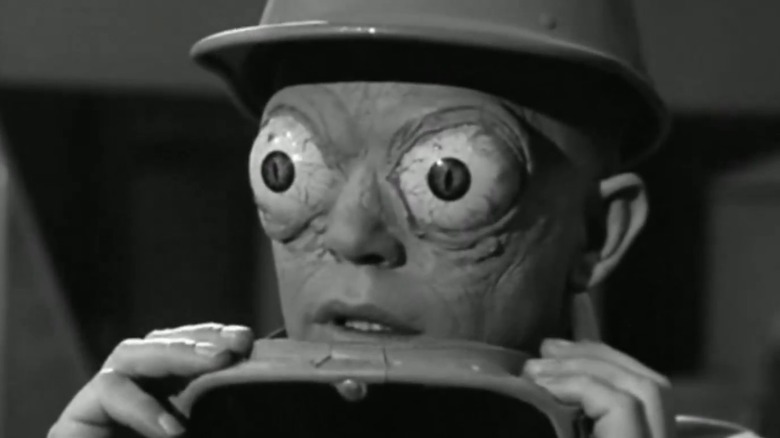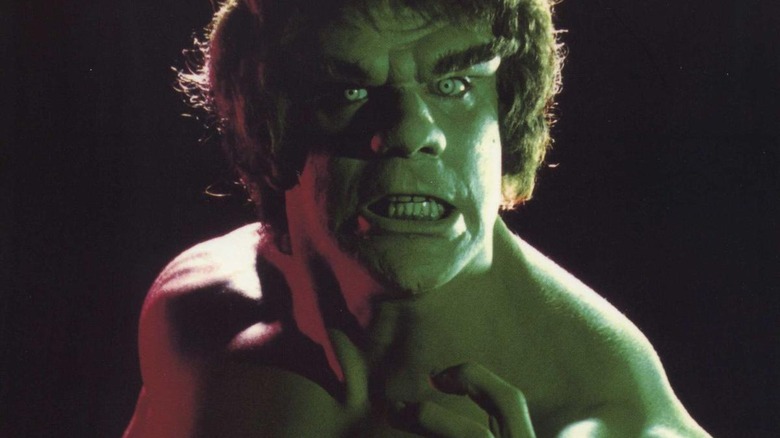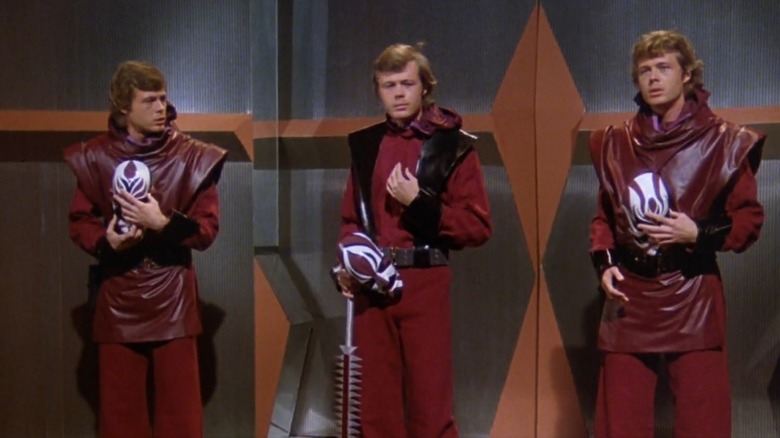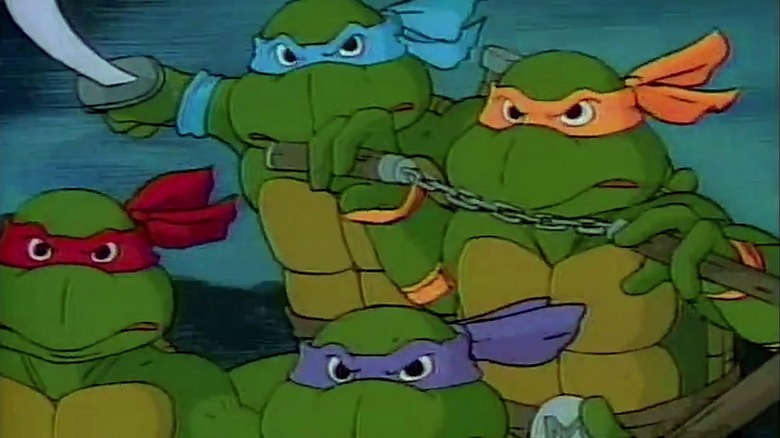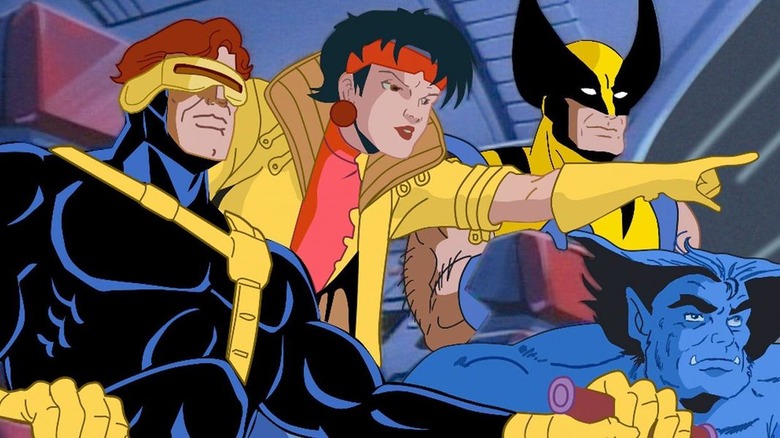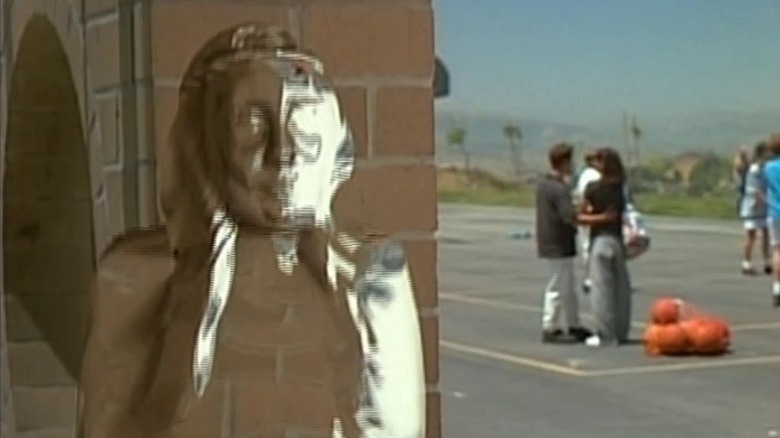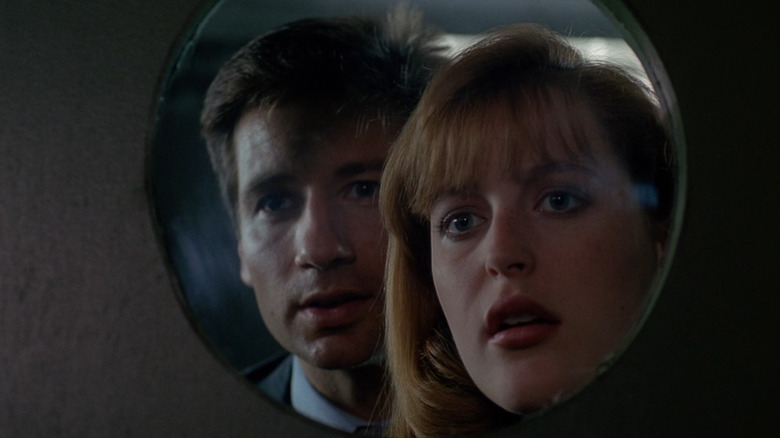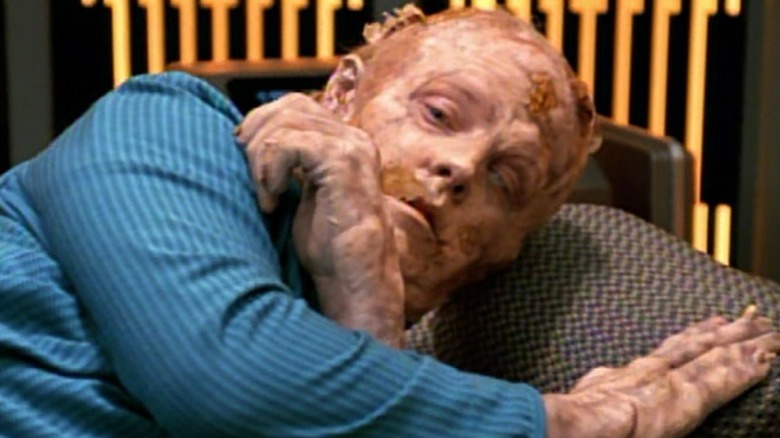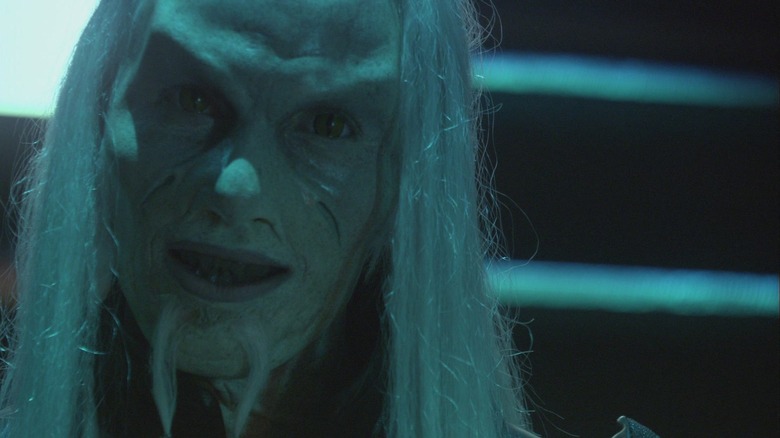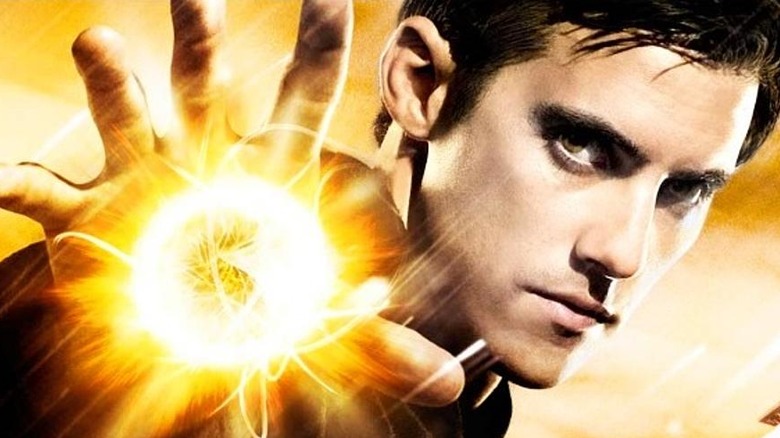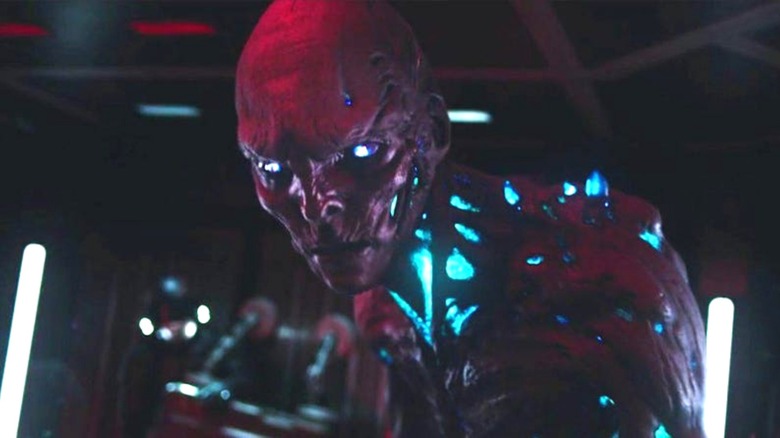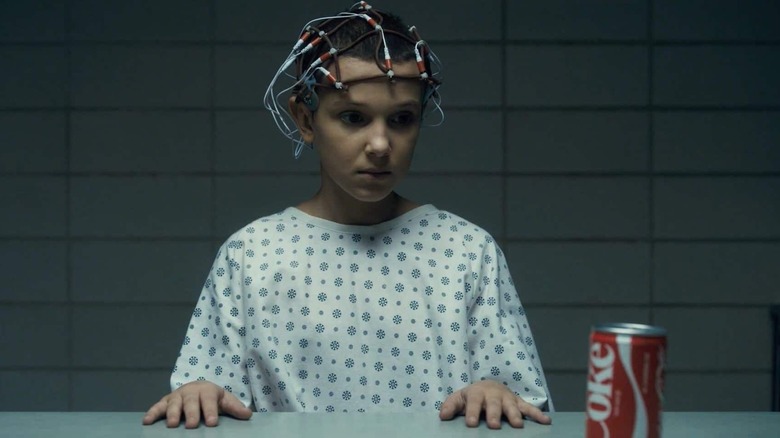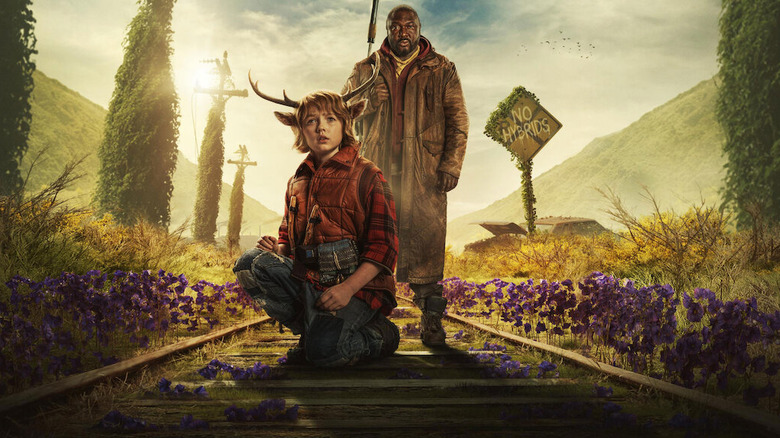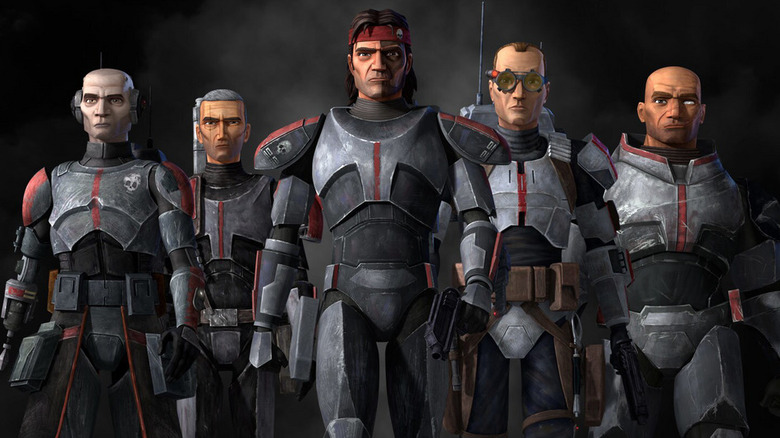The Best TV Mutations We've Ever Seen
Since the dawn of the nuclear age, humanity has found itself in awe of the destructive power of nuclear weapons and their radioactive effects. These fears fueled a vast array of popular concerns that nuclear power could mutate life, while science fiction authors imagined the myriad complicated transformations and powers that such uncontrollable energy could bring. Over time, other scientific issues came to the fore, such as the impact of new chemicals or the unforeseen consequences of genetic engineering. From the nuclear monster films of the 1950s to the quality sci-fi films and television of today, great creative minds have used fiction to explore what mutations could happen from radioactivity, chemicals, or even dormant elements of one's own DNA suddenly activating.
Here is a list of the greatest mutations that have graced our TV screens. Whether minutely small or unimaginably large, good or bad, powerful or simply odd, each example involves mutations of high conceptual quality that have made a large impact on the visibility and conceptualization of mutation in media. Some highlight the vast variations that mutations can bring, while one particular example showcases the hypothetical ability of these transformations to make us all the same. Without further ado, here are the best TV mutations we've ever seen.
Doctor Who's genocidal Daleks want to exterminate you
The Daleks, a species of genetically engineered mutants, are perhaps the greatest villains of the beloved BBC science fiction series "Doctor Who." Debuting in the 1963 episode "The Dead Planet," Daleks are all cyborgs with a living mutated body encased in a durable armored shell. They differ significantly from their humanoid ancestors, losing all humanoid features, excepting one remaining eye. What's worse is that behind the tough armor and weapons lies a genocidal heart bred to eradicate all non-Dalek life, and the only emotion they feel is xenophobic hatred. In the Tenth Doctor episode "Daleks in Manhattan," the Doctor explained that "inside that shell, there [was] a creature born to hate, whose only thought [was] to destroy everything and everyone that [wasn't] a Dalek, too."
While the exact origins of the Daleks is somewhat mysterious, with varied explanations that differ in detail, they were initially mutants created by the Kaled scientist Davros. The Daleks show the dangerous potential of mutations. From a planet of regular beings comes an entire species of genetically engineered, time-spanning murder tanks, ones bred to only feel hatred and a desire to exterminate all other life in the universe. You don't really get more terrifying than that, creating the biggest cautionary tale around mutants in TV history.
The Outer Limits' Mutant has vast power
With repeated revivals, "The Twilight Zone" is often remembered as the 1960's sci-fi/fantasy/horror anthology of the era that's most worth discussing. What's sometimes forgotten is the other great anthology sci-fi show of the time, "The Outer Limits." In its two-season run, it gave us a number of memorable stories and entities of all shapes and sizes. Season 1's episode "The Mutant" highlights an astronaut who investigates a group of Earth scientists on an alien planet. There's been a death, and the scientists suspiciously won't explain what happened. We soon discover that one of their number, Reese, has been mutated by the planet's isotope-contaminated rain and has gained superhuman abilities. The astronaut has to stop the superpowered villain despite the latter's abilities to kill easily and read human thought.
It's an interesting and shocking entry in the series, with considerable tension and a powerful nemesis. In addition to his godlike powers, Reese has grown massive, bulging eyes that he covers with goggles. The protagonists curiously defeat him with darkness: Ironically, his massive eyes are hurt by a lack of light rather than being excessively sensitive to it, but we're nonetheless left with a memorable adversary and an early, great instance of a singular, unique individual mutation in sci-fi television history.
The Hulk shows us a sympathetic monstrous side
Before the succession of cinematic Bruce Banners that graced the silver screen, we had 1978's "The Incredible Hulk," which lasted for five seasons with its story wrapping up over a succession of TV movies. The series saw Bill Bixby play Dr. David Bruce Banner, a man who travels widely and helps strangers despite his tendency to turn into an angry green monstrosity when angered or stressed (aka the Hulk, played by Lou Ferrigno). He's exposed to too high a quantity of gamma radiation, transforming him into the titular green entity, and the series sees him on the run while doing good deeds, forever an outcast with a monstrous side.
"The Incredible Hulk" captures the outcast Jekyll/Hyde dynamic that informs Hulk's early adventures perhaps better than his MCU-proper incarnations, with a strong highlighting of how the Hulk's potential to do good is complexly balanced against his misunderstood monstrous self. It's full of 1970s camp, sure, but it highlights the complex nature of a mutation that changes the self in involuntary but temporary ways ... a mutation that creates a second, uncontrollable being as a scientific side effect (as opposed to the supernatural, such as in 1941's "The Wolf Man"). It's a great series overall that adds considerable complexity to the potential of mutations and their effects.
Buck Rogers' Dorians aren't all the same ... or are they?
"Buck Rogers in the 25th Century" focuses on the 20th-century astronaut Buck Rogers, based on Phillip Francis Nowlan's 1928 character and his subsequent history of comics, novellas, and other media. In the series, while on a NASA mission, Buck finds himself in an ice storm that freezes him for 500 years. Fast-forward to the (surprise!) 25th century, and he has to assist people in that time. The 1979 series began with a feature film pilot and ultimately lasted two seasons. In the film, future Earth had suffered a massive loss of life from a nuclear holocaust, one that created many mutated humans in the aftermath. The dark tone of the pilot film was lightened in the subsequent TV series, but the premise started Buck on a host of adventures.
Each episode followed a diverse and unique threat, but the consequences of mutations re-emerged in "The Dorian Secret," an episode that followed a group that escaped the nuclear devastation of Earth long ago and created an independent community. They later have their own war, unleashing a unique mutation for every male of the species: They look exactly alike. It's an unusual take, having an entire population mutate into the same form rather than distinct ones, but the series as a whole finds a variety of complex threats that mutations could bring and is one of the more popular and influential sci-fi shows of the 1970s.
Manimal was short-lived but memorable (and mysterious)
"Manimal" was a short-lived but memorable series about Dr. Jonathan Chase, a man who has gained the ability to shape-shift into any animal of his choosing. He gained this ability from a mysterious African technique that allows him to be a "master of the secrets that divide man from animal, animal from man," according to the series' opening narration. He uses this ability to assist the police in solving crimes, and he transforms into a number of animals in the show's short run. Most regularly, Chase becomes a hawk or a black panther, but he shape-shifts on various occasions to a horse, snake, dolphin, bear, and even a bull.
Mutations in pop culture history take many forms, from growths to superpowers, involuntary permanent transformations to the ability to regularly change back and forth. Unlike supernatural transformations (like the bite of a werewolf or demonic possession), mutations are typically explained as consequences of changes to one's physical genetic makeup. While Manimal's exact mechanism of change is never fully explained, its general attribution to a secret that erodes the division between man and animal suggests something more biological, something perhaps tied to our common genetic lineage. Either way, it's an interesting and unique instance of a willful, multi-species mutation.
The Teenage Mutant Ninja Turtles became mutant icons
The "Teenage Mutant Ninja Turtles" franchise, based on the comic books of the same name, has been adapted into multiple animated series, a limited live-action series, and numerous feature films and video games since the comics' inception. The first animated adaptation, however, remains one of their strongest and most iconic. Running from 1987 to 1996, the series followed the four mutated and highly trained turtles (Leonardo, Michelangelo, Donatello, and Raphael) as they team up with reporter April O'Neil, friend Casey Jones, their sensei Master Splinter, and others to take on evil ninja group the Foot Clan and villainous overlords like the Shredder and Krang.
It's a massive, iconic, action-packed but family-friendly series full of some of the most widely recognizable fictional mutants of all time. Beyond the Turtles and Splinter (a large humanoid rat), the same mutagen that mutated them also caused other mutants like the Punk Frogs, Bebop, Rocksteady, Leatherhead, and more. The series launched the Turtles and its other fictional mutants into the popular zeitgeist, becoming a major cultural touchstone for fictional mutants everywhere.
After the X-Men, mutants were a household name
When it comes to widespread recognition of mutants in popular culture, perhaps no creation has done more to make mutants a household name than the X-Men and their mutant allies and enemies. Based off their comic counterparts (whose modern lore roots as an independent subspecies goes back to Stan Lee's 1963 series "X-Men"), the 1992 series "X-Men: The Animated Series" made Marvel's mutants a household name. In Marvel lore, all mutants have an X-gene, a genetic mutation that causes their bodies to develop abilities and capacities beyond what other human beings can do. Mutants often develop these abilities around puberty (often triggered by trauma), and they can be anything from physical transformations to vast arrays of powers to relatively minor changes.
Some of the most interesting, unique, and popular mutants of all time are part of the Marvel canon. From powerful telepath Professor X to the master of magnetism Magneto, the vicious Wolverine, the powerful Apocalypse, or the incredible Storm, Marvel's mutants became household names more so than any other, expect perhaps the Ninja Turtles. Through the X-Men and the popularity of the cartoon (not to mention the subsequent film series), Marvel's mutants became a massively popular and influential set of powerful mutated heroes.
Alex Mack brought complex mutations to a live-action kids' show
A mid-'90s Nickelodeon children's classic, "The Secret World of Alex Mack" centered on the story of regular teenage girl Alex Mack, who gets doused in a secret chemical (GC-161) when a truck nearly hits her. She gains a host of powers from the accident, including telekinesis and the abilities to shoot electricity and morph into a liquid state that becomes a sort of sentient metallic puddle. The latter is her most distinct and famous power, used in every episode except "World Without Alex."
It's an interesting kids' series where Alex has to deal with her complex array of powers and work against the machinations of dastardly supervillains while being a young teen. It's also an extreme case of mutation, as the powers she receives allow her to completely change not only her form but her state of matter (not to mention the abilities having little obvious logical relation to each other). This makes for an original property and one of the more unique superhero tales on TV, all stemming from a chemically induced mutation.
The X-Files' Flukeman is a terrifying hybrid
"The X-Files" tells the story of two FBI agents, Fox Mulder and Dana Scully, who investigate marginalized, unsolved, and often paranormal cases. This leads the pair to pursue a wide range of phenomena, from alien abductions to ghostly apparitions to cryptids, with monster-of-the-week episodes following particularly unique one-shot investigations. In their time at the Bureau, Mulder and Scully have come across a number of shocking mutants, like Eugene Victor Tooms, a serial-killing genetic mutant who can squeeze through impossibly tight spaces and emerges every 30 years to consume human livers before returning to hibernation.
Another of the more shocking mutants discovered in their investigations is Flukeman, a genetic anomaly that stalks the New Jersey sewer system. Appearing in the 1994 episode "The Host," Flukeman began life on a decommissioned Russian freighter. Surrounded by radioactive sewage, Flukeman grew to become a form of quasi-vertibrate humanoid with a combination of primate-like body with parasitic, flatworm-like elements. It gets flushed out to sea, emerging later in New Jersey and coming to the attention of Mulder and Scully. It's a stunningly good design and a shocking mutated creature, showing the creativity of "The X-Files" at its peak.
Tom Paris brings mutations home to Starfleet
Flight Control Officer Tom Paris is a 24th-century Starfleet officer who serves aboard the USS Voyager under Captain Kathryn Janeway. Like the rest of the Voyager crew, he gets transported far across the galaxy to the Delta Quadrant. Unlike the rest of the crew, Tom has an unfortunate incident that shows him the power of mutations firsthand. In the 1996 episode "Threshold," Tom pilots a special warp-capable shuttlecraft that allows him to break the transwarp barrier (making him the first human ever to do so) by hitting Warp 10. Tom gets progressively sicker, becomes allergic to water (of all things), and mutates into a decreasingly human thing before having his humanity restored.
Okay, it's not one of the best "Star Trek" episodes out there. (On the DVD commentary, Brannon Braga called it a "real low point" and the one "Voyager" installment he would "just as soon forget.") But it's still one of the more memorable instances of mutation in the "Trek" universe, one that happens to a notable Starfleet officer and brings the dangers of mutation home. The source of the mutation is also interesting, stemming from a desire to see what would happen if one travels at the speed of Warp 10 (a limit set by Gene Roddenberry as a fundamental rule of space travel).
Stargate: Atlantis' Wraith were a galactic menace
The initial "Stargate" film, about the discovery of an alien gate (built by the mysterious spacefaring Ancients) that connects our world to a vast interstellar network of worlds, produced a series of spin-offs. "Stargate SG-1" focused on a special forces team that must defend the Earth from threatening alien species like the Goa'uld, the Ori, and the Replicators. "Stargate: Atlantis" expands the universe by introducing Atlantis as an Ancient stronghold. We discover that the Ancients had suffered considerable losses from a mysterious enemy, the Wraith. When the Ancients traveled to the Pegasus galaxy, they attempted to seed human life there, finding little life available. One such seeded planet contained the Iratus Bug, a vampiric insect that fed on humans until the DNA of the two began to merge over millions of years, accidentally creating the Wraith, a mutated hybrid of the two species.
In short, the Wraith are a galaxy-spanning species of space vampires who are the product of mutation. In the novel "Stargate Atlantis: Legacy: Secrets," it's even speculated that the Wraith may have been an intentional genetic mutation, a project of the Ancients to help the newly seeded humans of the Pegasus galaxy survive. Either way, they're an intriguing example of a hybrid mutation whose advantages have made them a widely feared galactic threat.
Peter Petrelli's godlike empathy showcased Heroes' vast mutations
The American superhero drama series "Heroes" was an absolute phenomenon when it premiered in September 2006. The series told the story of people around the globe who suddenly had superhuman abilities awakened in them due to a variety of mutations in their genetic code. The powers vary to various extremes. Claire Bennet is a cheerleader who regenerates from damage. Hiro Nakamura can manipulate space and time. Sylar can figure out how anything works, including others' superpowers. While, like the X-Men, the mutants here could be perhaps lumped under one rhetorical umbrella as the focus of this entry, in this case, the series boasts a character who could at one time have the powers of all of them: Peter Petrelli. Peter has super-empathy: He can mimic the abilities of anyone he encounters.
"Heroes" was a great, real-world spin on an "X-Men"-style story that, at its peak, had some of the best genre storytelling on TV. And while some characters had vast amounts of power, none was as impressive at his best than Peter Petrelli. Not only can his unconventional powers mimic the abilities of any superpowered person, but they're strictly an outgrowth of his empathy... His extreme powers are tied to his humanity. It's a deep and unique way to give a character almost godlike abilities, and it showcases the extent of power the series' mutations can bring.
The Hybrids of The Expanse were scary and memorable
"The Expanse" is another fantastic sci-fi show with a sociological bent, taking place in a future where humanity has colonized the solar system. There's increasing conflict between the three major powers of the system: the United Nations of Earth and Luna (the political seat of humanity), the Martian Congressional Republic (with a strong military arm), and the Outer Planets Alliance of the asteroid belt and various outer moons (whose mining operations are heavily relied upon). The state of the solar system (already bordering on war) is turned upside down with the discovery of the Protomolecule, an alien infectious agent that can transform matter according to its programming. It was, we discover, scattered among the stars to prepare for interstellar communication and travel ... but it's capable of having side effects from its vast transformative powers.
The humans' secretive Project Caliban attempts to use the Protomolecule to create super-soldiers. Children are captured and taken to the moon Io, experimented on with the mysterious alien Protomolecule. The results of the project are Hybrids, large humanoids with protruding growths and considerable strength and resilience. Using alien technology to create mutated bioweapons from captured children is a frightening, evil prospect that adds major villainy and a considerable threat to the world of "The Expanse," and it showcases the potential of rogue science to create mutated weapons.
Eleven in Stranger Things
Netflix's ever-popular "Stranger Things" takes a nostalgic journey into 1980s Hawkins, Indiana, where the experiments of the shadowy Hawkins National Laboratory produce a gateway to a dark reflection of our reality, the Upside Down, that results in extradimensional monsters (like the Demogorgon and the Mind Flayer) infesting our world. Most interestingly among our protagonists is the incredibly powerful young girl known initially as Eleven, an escapee of the facility whose psychic abilities were accidentally pivotal to creating the connection to the Upside Down in the first place. She was a child test subject of the laboratory, kidnapped, raised, and experimented on until her escape early in the show's first season. The facility's mid-20th century MK-Ultra experiments on Eleven's mother Terry Ives created mutations in her daughter that gave the young girl surprisingly powerful abilities.
What's most interesting about Eleven is that her manifested powers emerged from experiments on the girl's mother, affecting and changing the girl in the womb to have abilities that (as far as we know in the show's world) have no precedent in human history. While the experiments did produce other children with powers, Eleven is easily among the most powerful, and her mutations allow her to successfully combat even the extradimensional alien conqueror dubbed the Mind Flayer. It's an interesting case of experiments producing a genetic mutation in utero, and it created abilities that are otherwise unknown among humanity — a powerhouse mutation in a great sci-fi-horror series.
The hybrids of Sweet Tooth
Netflix's "Sweet Tooth" is based on the comic series by Jeff Lemire, and it highlights the aftermath of the Great Crumble, a viral pandemic that kills a huge percentage of the world's population simultaneous to the emergence of a population of hybrid children. These hybrids are born part-human, part-animal, and the children can vary from being predominately human in appearance with a small amount of animal-like features to being incredibly animalistic. In this world, the popular association between the virus and the hybrid appearance of these children (combined with popular confusion over the nature of the hybrids) causes them to be widely hated and hunted, and we watch as young deer-hybrid Gus travels across a dangerous land to find his supposed mother.
"Sweet Tooth" presents a visually and conceptually unique world, and it shows both the amazing potential diversity of mutations as well as the human capability for genocidal hatred against the different. In a way, the series takes a theme common to "X-Men" — given the widespread existence of mutations (even in children), a number of humans would attempt to genocidally erase them from the planet. It's shocking, sad, and ultimately thrilling, but altogether, it's a show that uses mutations to show the darker potential in humanity.
Clone Force 99
The "Star Wars" universe boasts one of the most menacing, villainous groups in sci-fi history, the Sith Lords, whose depravity and lust for power know few bounds. With their mastery of cloning and the darker art of Sith alchemy, those who follow the Dark Side of the Force have pursued the intentional mutation and creation of many dangerous beasts and fearsome warriors over centuries of war.
Sith machinations led to the creation of cloned soldiers to be used by the Republic in the aptly named Clone Wars. "Star Wars: The Bad Batch" follows Clone Force 99, a group of aberrant clones whose mutations, on one hand, give them abilities beyond those of typical cloned soldiers. On the other hand, the mutations caused the clones' inhibitor chips to fail, leading to Clone Force 99 (other than Crosshair, whose chip still works) disobeying the villainous Order 66, Palpatine's betrayal of the Jedi Order that demarcated the rise of the Galactic Empire.
The mutations were thus, for the Empire, a hit-and-miss situation: They could successfully breed more powerful soldiers, but Clone Force 99's mutations gave the soldiers a will independent of the dictates of the Empire. They're a pivotal element of one of the most popular genre franchise of all times and a great example of mutants whose mutations are used for heroism.

